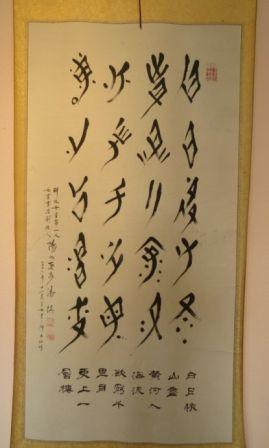Tools
Dictionary of Nushu Standard Characters (《女书标准字字典》) compiled by Gong Zhebing (宫哲兵) and Tang Gongwei (唐功𬀩), currently supports 4200 Chinese characters.
- Converter of Dictionary of Nushu Standard Characters The Nushu converter based on the book Dictionary of Nushu Standard Characters
- Online Search Tool of Dictionary of Nushu Standard Characters An online search tool based on the book Dictionary of Nushu Standard Characters, which is able to search for the pronunciation of Chinese characters in Jiangyong dialect and the corresponding Nushu characters
Calligraphy Copybook of Nushu Standard Characters (《女书规范字书法字帖》) compiled by Zhao Liming (赵丽明) and Xu Yan (徐焰), currently supports 1760 Chinese characters. This is included in the Unicode standard.
- Converter of Calligraphy Copybook of Nushu Standard Characters The Nushu converter based on the book Calligraphy Copybook of Nushu Standard Characters
- Unicode Nushu List The correspondence between all of the 396 Nushu characters in Unicode and Chinese characters
- Nushu Input Method Input Nushu by romanization of Jiangyong dialect as well as Standard Chinese
Resources
- Typesetting Guide for Nushu Websites (in Chinese)
- Research on Jiangyong Dialect authored by Huang Xuezhen (in Chinese)
Introduction
Nushu (𛆁𛈬, 女书) is a mysterious script used exclusively among women in Jiangyong County of Southern China. It is handed down by mother to daughter among the Han and Yao people from generation to generation in Jiangyong County and its adjacent areas, becoming a unique cultural phenomenon in human history.
Nushu characters are rhomboidal in shape, slim in style and imaginative in the form. The total amount of the characters being discovered is up to two thousand, all of which contain solely four kinds of strokes – dotted, vertical, oblique and arcuate.
Although Nushu is derived from Chinese characters, there is no absolute correspondence between them. Unlike Chinese Characters, Nushu is a syllabic script, for every character of it represents either a syllable or a group of syllables that are similar in pronunciation. Meanwhile, the characters accommodate to be curved in shape, because they are also embroidered on clothes and flower belts besides being written down.
The earliest record of Nushu script is the Diaomu coin (雕母钱) issued by the Taiping Heavenly Kingdom during the Xianfeng Period in Qing Dynasty. The Nushu characters “women all over the world are sisters in one family” were carved on the backside of the coin.
Nushu is used to record the local dialect. It could be written on cotton books as wedding gifts, which are called “third day missives” (三朝书), or written on fans, handkerchiefs and papers. It is also embroidered on handkerchiefs. Women in the local areas used to do the needlework together, reading, singing and teaching Nushu. Such activity forms a special Nushu culture.
In 1982, Professor Gong Zhebing (宫哲兵) from Wuhan University discovered Nushu in Jiangyong County, Hunan Province. The discovery caused a sensation throughout the world. Experts and scholars at home and abroad leave for Jiangyong to do investigation, learning and discovery. In recent years, projects for rescuing and protecting the Nushu culture are being actively carried out in Yongzhou City. People carry forward and promote the culture by building Nushu villages and Nushu museums, making Nushu craftsmanship and developing Nushu culture industry. Proposal for encoding Nüshu in the SMP of the UCS, Comparison of the characters used to write Nüshu (女书用字比较) and several other documents are made by a group of student from Tsinghua University. They are also the representatives to submit the encoding proposal.
The Online Nushu Dictionary is an open-source project maintained by the Nushu Developers Workgroup, containing the Nushu converter, Nushu list and Nushu IME. It is a comprehensive website for the Nushu script.
Gallery


Maintenance
Online Nushu Dictionary is an open-source project, your contributions are cordially welcomed!